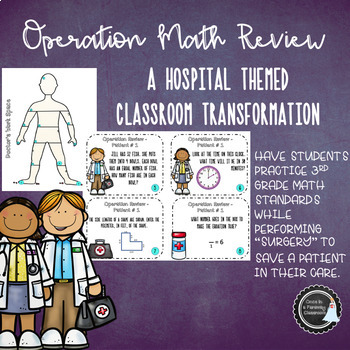3rd Grade Math Review - Classroom Transformation
- PDF
What educators are saying
Description
3rd Grade Teachers -
Are you looking for an engaging way to review all math standards before the state test? Are you looking for a fun way to end the school year while still engaging in meaningful content?
Look no further! Practice your math standards using hospital themed task cards to allow students to "perform surgery" on various patients. For each patient, students will solve 12 problems and receive a puzzle piece for each problem solved correctly. Once they have successfully put the patient back together, they can move on to the next patient and save another life!
This can be used as basic task cards or used for a classroom transformation where students can dress up as doctors and enter your classroom "hospital". Use your imagination!
Product includes:
Patient Chart Covers - Black and White and Color
Doctor Name Tags - Color
Patient Diagram
12 Task Cards per Patient
Patient Answer Key
Work Space for each doctor to record their work





